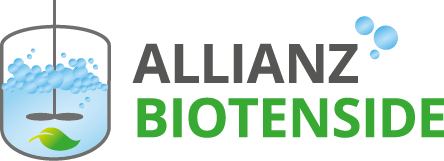Tasks and solution approaches
Objectives
The Innovation Alliance Biosurfactants is the first strategic alliance in Germany between well-known companies and research institutions to find sustainable and scalable alternatives to chemically synthesized surfactants that have so far been made from fossil raw materials. For this purpose, we research and develop the process engineering production of biosurfactants using biotechnological methods based on domestic renewable raw materials and residues and systematically examine their application potential.
Results of the first funding phase (2018 – 2020)
During the first funding phase (2018 – 2020), the provision of regionally available raw materials containing sugar, fat and oil was used, various microorganisms for the production of different biosurfactant classes were examined and promising candidates for subsequent process development on a laboratory scale were selected.
The process development included, on the one hand, the optimization of the microbial and enzymatic production of various biosurfactant structure variants and, on the other hand, the further development of the downstream processing to obtain purified biosurfactants.
The biosurfactants were then made available for application studies and potential areas of application were identified.
The work was accompanied by life cycle assessments and techno-economic evaluations.
The final project report on the first funding phase of the Biosurfactants Alliance is available in German on the TIB portal:
Final reports of all sub-projects within the first funding phase
Working plan for the second funding phase (2021 – 2024)
In the second project phase, the implementation of the scale transfer takes on greater importance. However, a fermentation should only be meaningfully scaled to the next order of magnitude if robust, controllable and automated processes are available and when there is also the option of purifying the large amounts of fermentation broth. Unknown biological characteristics and missing equipment or technical developments on a larger scale pose considerable risks for an early scale-up in the m3 scale. In fermentation, for example, this can lead to uncontrolled foaming, overdosing of feed or the depletion of essential nutrient components come. This leads to a non-reproducible biosurfactant synthesis or the process might have to be stopped completely.
When looking at the purification route, complex downstream processing is often the biggest cost driver. Existing and innovative technologies have to be examined, linked together and optimized so that the number of processing steps for biosurfactants is minimized. In the second project phase, the partners devote themselves to this holistic process-related risk and cost minimization.
In the first phase, a larger portfolio of biosurfactants was examined and some of them were already assigned to the different areas of application with regard to their performance. In the second phase, these biosurfactants are characterized in more detail in the individual areas. This is only possible with larger sample quantities from the 100 g scale.
In addition, studies to check the safety profile for the environment and humans are necessary. In the second project phase, hazard analyzes are therefore carried out and safety data sheets created in order to identify necessary investigations for individual biosurfactants in the specific areas of application. This is particularly necessary because criteria (regulations, guidelines) can differ fundamentally for each area of application.


